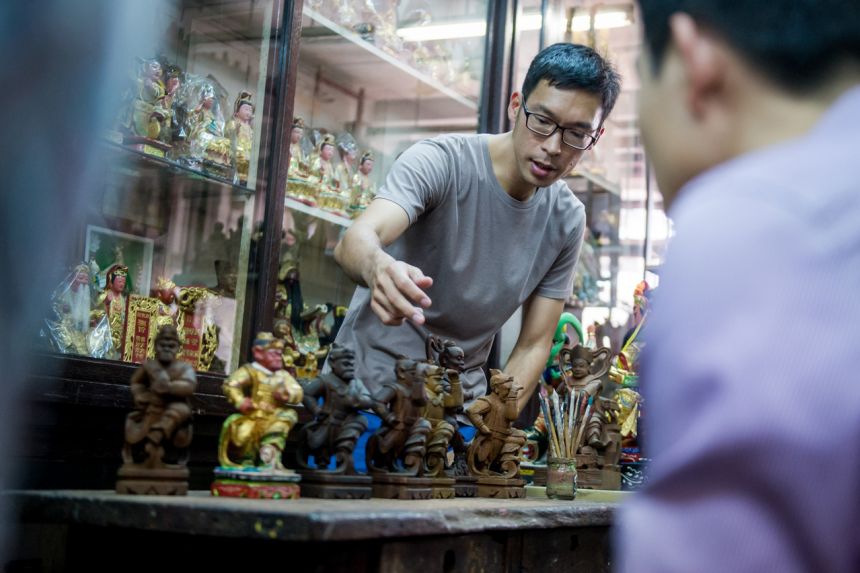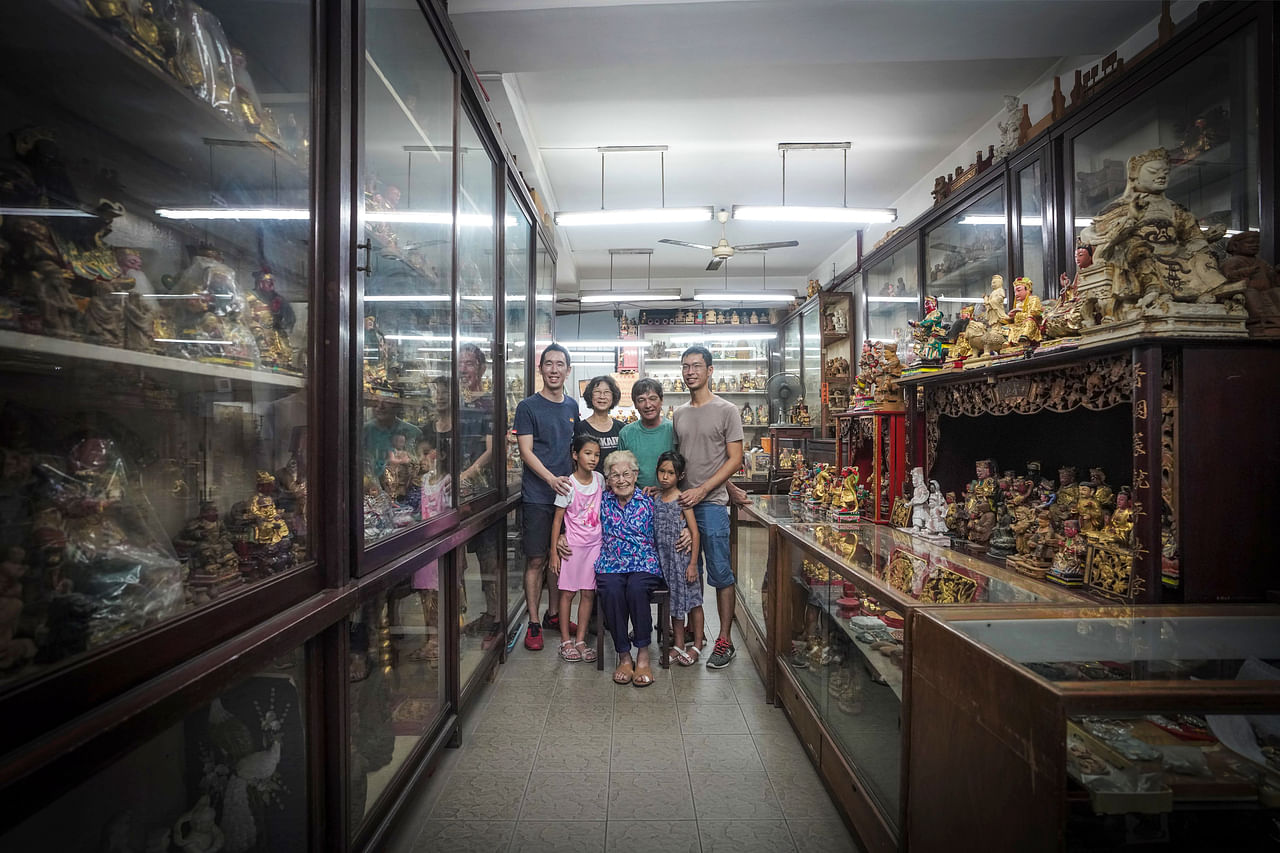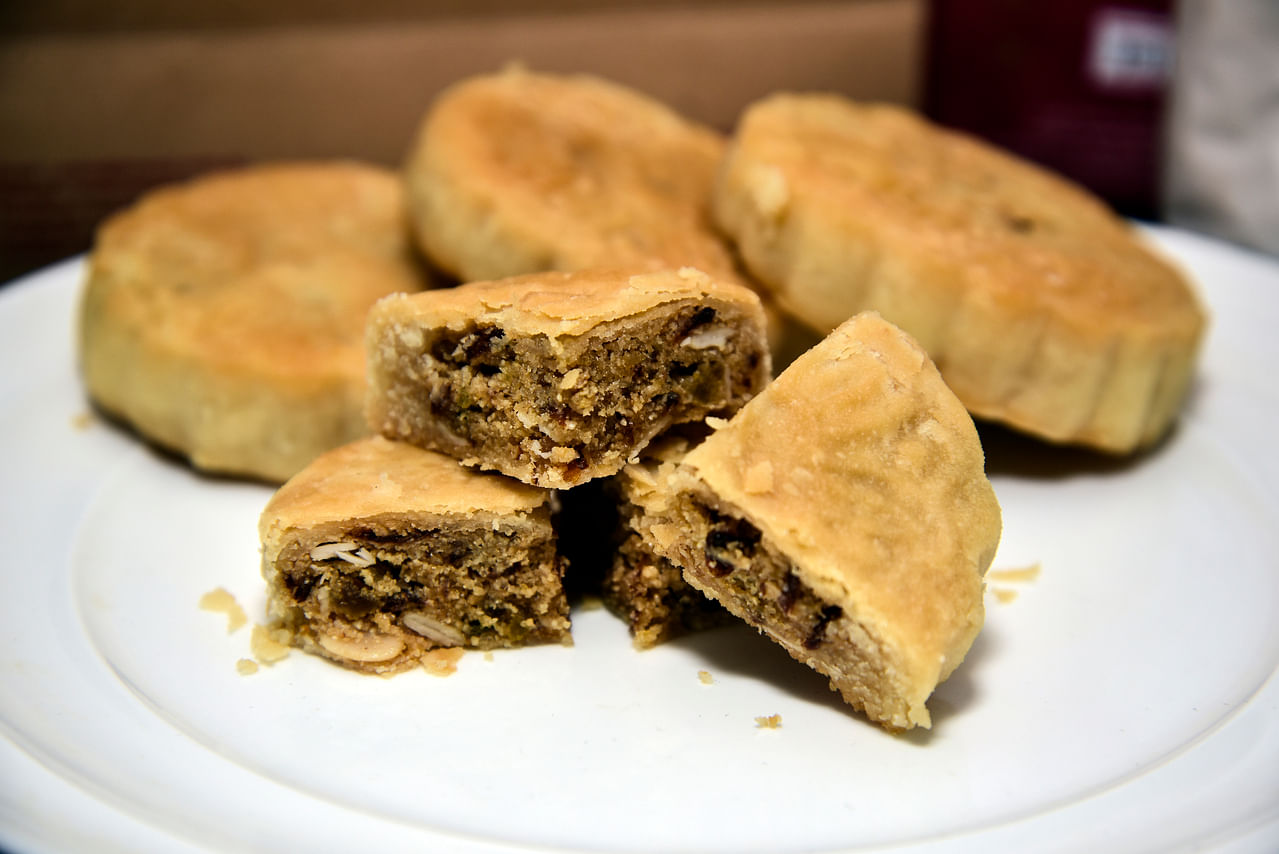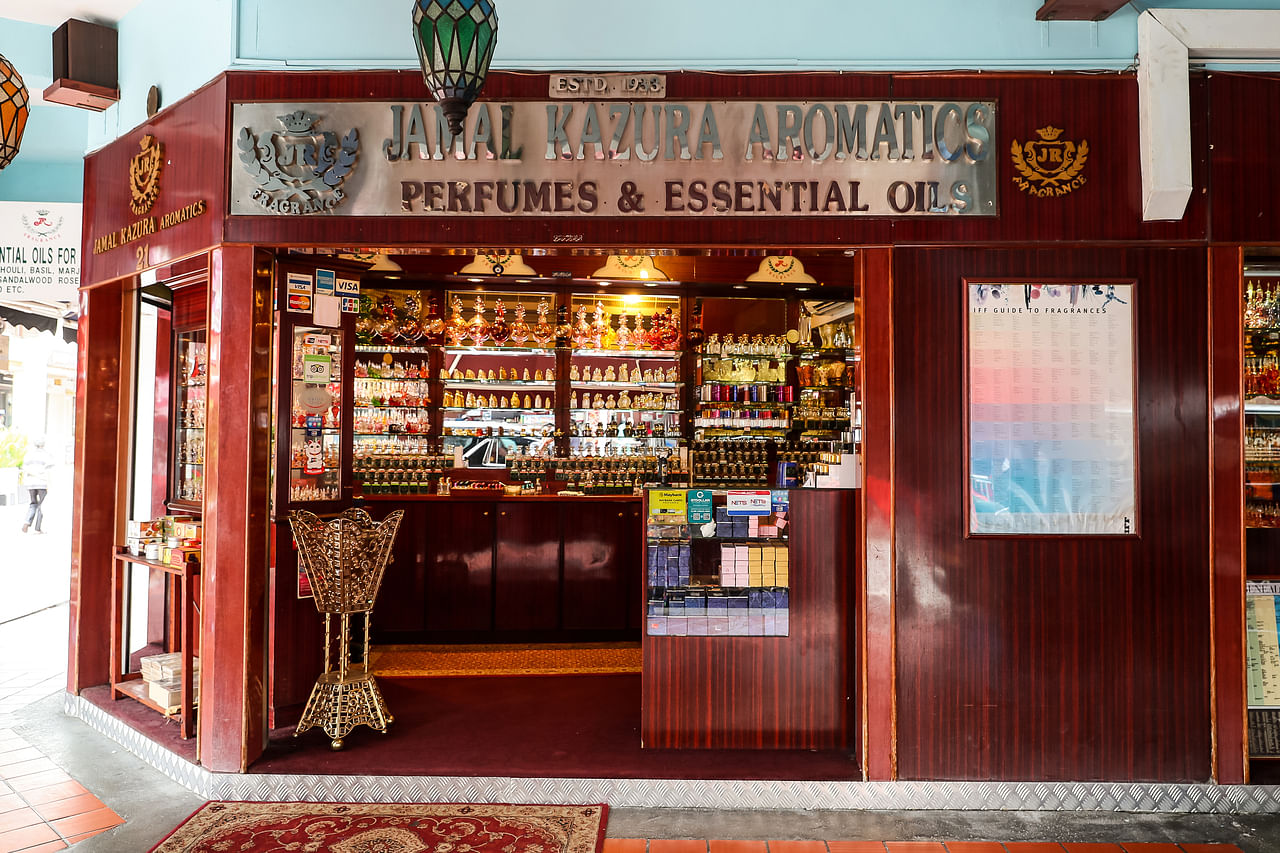'If I don't do anything, the shop will close': New hope as heritage businesses get help to transform
Sign up now: Get ST's newsletters delivered to your inbox

Mr Ng Tze Yong, a practitioner at Say Tian Hng Buddha shop, explaining the origin myths of Taoist deities to locals and tourists.
PHOTO: JOSEPH NAIR
Follow topic:
SINGAPORE - In a fast-changing world, whither the future of heritage businesses?
Even pre-pandemic, these usually family-run operations were already finding the going tough, with their labour-intensive products underappreciated by the mass market.
But the pandemic sounded a further death knell. Tourist numbers were shot; foreign manpower returned to their countries; people spent less on perceived luxuries.
The National Heritage Board (NHB) this year instituted a time-limited Organisation Transformation Grant, aimed at helping struggling heritage businesses innovate so they can find their place in today's world.
Applications for proposals opened from June 15 to Sept 1, with each project eligible for up to $30,000.
A total of 12 projects have since been given the go-ahead. NHB said this could set these heritage organisations up for long-term sustainable growth beyond the grant funding period.
Here are three of them.
Handcrafted Taoist statues go high-tech with 3D scan
Tracing its history to 1896, Say Tian Hng Buddha shop, which sells handcrafted Taoist effigies, is one of Singapore's oldest heritage businesses.
Mr Ng Tze Yong is now the fourth-generation practitioner at the shop. He is 41 this year. His father is nearing 70, his grandmother almost 90.
The problem: He is still apprenticing in the craft, spending one day a week learning how to draw the eyes on the sometimes palm-sized effigies. With his dad and grandma getting on in age, Mr Ng is worried he is running out of time.
“If I don’t do anything, the shop will close in a few years’ time,” he said. “I need to find a way to codify the knowledge before it disappears.”

Say Tian Hng Buddha Shop, run by the Ng family (pictured), is one of Singapore's oldest heritage businesses, tracing its roots to 1896.
PHOTO: NICKY LOH
He is compiling an online instruction manual - including videos - for himself as he learns, to aid his memory. But with the NHB grant, he is now thinking bigger, hoping to create a 3D scan database of at least 30 masterpieces that he has in the shop.
Not only will he be able to keep taking reference from them after they are sold, but he will also be able to 3D print them later. Digital copies of the designs could even be fed into a Computer Numerical Control machine that carves statues.
“Some customers don’t mind paying more for the statues to be hand-carved, while others rather not. The 3D scans thus allow us to serve both groups, strengthening our business model,” he said.
These 3D-printed or machine-carved statues will still need to be painted and gilded by hand, which Say Tian Hng Buddha shop will continue to do.
The making and repairing of Taoist effigies from scratch by hand takes months. Mr Ng's grandmother took a year to learn the craft after she married into the shop when she was 18, but she slogged at it every day, instead of just once a week.
The eyes of the effigies are the most important, conveying fierceness, compassion or other qualities that the deities should represent. It is what people connect with and look for when they buy deities, even though the eyes are often barely the size of a rice grain.
“They need to be symmetrical, which is hard to do on a 3D surface. Small deviations are obvious,” Mr Ng said. "You look into the eyes when you connect with humans; it is the same with effigies."
He recognises that the youth in Singapore are becoming increasingly secular, so he is designing a curriculum for children aged seven to nine that teaches them more about characters in Chinese culture - often depicted by Taoist effigies - and their associated moral values.
"It will be quite experiential. In Romance of the Three Kingdoms, the three brothers' oath of fraternity in the peach tree garden held them together through decades of war," Mr Ng said.
"We can put children in situations where they have to decide, for example, whether to steal chocolate or to keep to their promise. Today, friendship is defined by a 'like' on Facebook, but this will help them realise that a true promise comes at a cost."
The curriculum should be ready next year, with a decision made on how it could be incorporated into schools.
Mr Ng added: "You don't need to pray to a deity to appreciate his timeless qualities and ancient legends. It is about philosophy, culture, history and design.
"I don't see them as statues. I see them as stories."
Bakery's traditional Hainanese biscuit mistaken for mooncake
A family recipe from the 1920s plus a unique identity as the only shop in Singapore that bakes traditional Hainanese pastries. An unbeatable business plan?
Wrong.

When Mr Chong Suan, 47, co-founded Chuan Ji Bakery with his 82-year-old mother in 2017, he underestimated how difficult it would be to get a heritage business off the ground.
A brief bout of demand for his flaky biscuits, called au yan bing, during the Mid-Autumn Festival that year quickly faded. Attempts to get help from the Singapore Tourism Board fell flat because the shop in MacPherson was away from tourist hot spots such as Chinatown.
"I was a bit naive," Mr Chong said. "We had a recipe passed down from our grandparents from 98 years ago, but business went quiet. People knew the biscuits as Hainanese mooncakes, so they wouldn't buy them at other times of the year."
Au yan bing is a traditional Hainanese biscuit made with two types of dough - one crispy and one more doughy, so there is a "multilayer of silkiness in the biscuit", said Mr Chong.
It comprises 13 ingredients, including sesame seeds, orange peel, melon seeds, preserved lime and shallots.
The manufacturing process is extremely labour-intensive, with much of it done by hand. For example, the types of dough used means the biscuit has to be moulded by hand or it will stick to the mould.
The wrapping of the ingredients with the dough must also be done by skilled workers who can stretch the dough thinly without breaking it.

But certain processes can be automated, and with the NHB grant, Mr Chong is doing research and development with a vendor to see if current machines on the market can be modified for his specific purposes.
One such process is the measuring out of the 13 ingredients that go into each biscuit.
He said: "We sell up to 22,000 pieces during the Mid-Autumn Festival, so setting apart the correct quantities of ingredients for each one can be very time-consuming. Some of our workers left us in recent years because it takes up too much time, and affects their commitment to their families.
"This should help to reduce the manpower needed."
Mr Chong has a background in mechanical design engineering and is hoping his knowledge from his past will serve him well.
"My mum is ageing, and it is difficult to get staff. There's a lot of pressure now. I also want people to know that this is a biscuit, not a mooncake. It is a delicacy that you can consume daily."
Kg Glam perfumery smells salvation in e-commerce amid Covid-19
The absence of tourists in the last two years has seen sales of traditional perfume and essential oils at Jamal Kazura Aromatics plummeting by almost 80 per cent.
The perfumery in Kampong Glam, set up in 1933, specialises in non-alcoholic perfumes, or attar in Arabic, by blending essential oils such as those derived from saffron, sandalwood and frankincense.

It was previously patronised largely by pilgrims going on the haj and the congregants at the nearby Sultan Mosque. Over the years, it has also become a hot spot for tourists, with those from Japan, China and South Korea in particular frequenting the shop.
"We were all surprised that it found a market with East Asian tourists who might be more used to commercial perfumes that are mixed with alcohol," said Mr Mohamed Samir Kazura, 38.
"We are hoping to do the same with young people here and increase awareness of perfume oils, which is still a very niche product."
Mr Samir, the grandson of the shop's founder, is helming a rebranding of the perfumery.
The pandemic has forced the shop to more aggressively market its products to locals, with the previous ratio of 70 per cent tourist to 30 per cent local customers no longer tenable.
It is a tricky exercise, Mr Samir admitted, as "we want to appeal to the younger generation of today while preserving the heritage aspects of our business".
His proposal to the NHB is to take the business online - with an e-commerce platform and a social media campaign.
He is looking at everything from a new brand concept to a new product line, and is willing to also create some products with a bit of alcohol infused so that they are more mass market-friendly.
He is also exploring massage oils, aromatherapy and air diffusers. Young people currently make up a very small percentage of the shop's clientele.
Perfume oils that are not mixed with alcohol have a more subtle smell but lasts a lot longer. Commercial perfumes, which are 90 per cent alcohol, atomises almost immediately so people can smell it immediately. But it also vapourises faster and wears out sooner.
Mr Samir said that with e-commerce, he may also be able to reach regional customers or tourists who may not be able to visit the shop in Singapore.
"Even with the vaccinated travel lanes, we are not seeing tourist volume return," he said. "Hopefully, more people will be open to perfume oils."

